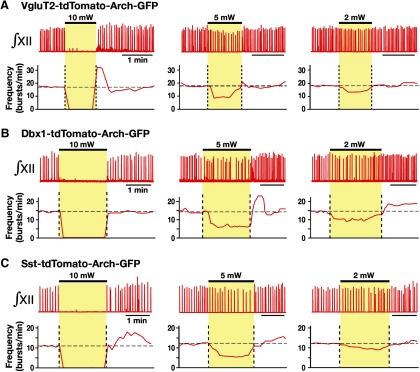Figure 9.
Population-specific Arch-mediated optical perturbations and inhibition of inspiratory rhythm in rhythmically active neonatal mouse in vitro medullary slice preparations. A–C, Experiments from VgluT2-tdTomato-Arch-GFP (A), Dbx1-tdTomato-Arch-GFP (B), and Sst-tdTomato-Arch-GFP (C) triple-Tg mouse lines. To systematically analyze the relationship between steady-state frequency and laser power (2-10 mW), we applied single epochs of continuous orange (593 nm) laser illumination (1-2 min). Representative traces of inspiratory network activity monitored by integrated XII nerve (∫XII) recordings, illustrating laser-induced perturbations of inspiratory frequency during bilateral pre-BötC illumination (2, 5, and 10 mW). In all cases, laser application caused rapid and reversible reductions of inspiratory frequency (time-based moving median, solid red lines in panels below the ∫XII traces in A, B, and C) in a laser power-dependent manner with the complete cessation of the inspiratory rhythm at the maximum applied power (10 mW).

